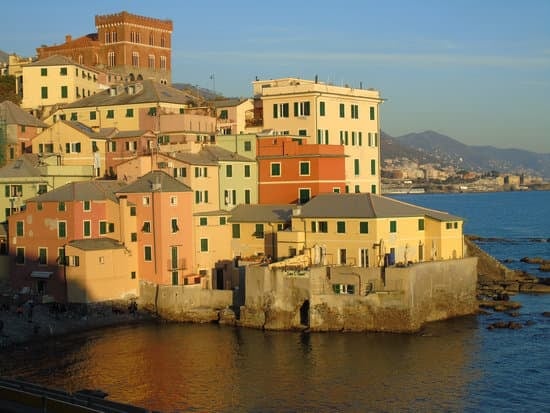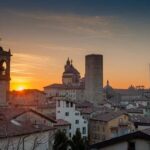Traveling from Serbia to Italy is a breathtaking and enchanting journey that takes you through stunning landscapes, vibrant cities, and diverse cultures. Whether you are seeking historical landmarks, picturesque countryside, or delicious cuisine, this travel adventure promises to be an unforgettable experience. In this blog post, we will delve into the allure and excitement of traveling from Serbia to Italy, capturing the reader’s attention and setting the scene for a remarkable exploration.
As you embark on this journey, you will discover that Serbia itself holds its own charm and attractions that may entice you to stay longer than planned. From the lively capital city of Belgrade to the tranquil beauty of Novi Sad and the historic sites of Nis, Serbia offers a unique blend of ancient history, vibrant culture, and warm hospitality. We encourage readers to explore these gems before departing for Italy and soak in all that Serbia has to offer.
Navigating through the Balkans can sometimes be overwhelming with numerous options available for transportation. In this blog post, we will recommend the optimal routes and modes of transportation for reaching Italy from Serbia. We will provide information on trains, buses, and flights along with visa requirements to ensure a smooth transition between these two countries. So sit back, relax, and let us guide you through this beautiful journey from Serbia to Italy.
Serbia’s Charm
When traveling from Serbia to Italy, it may be tempting to quickly pass through Serbia and head straight to the allure of Italy. However, Serbia is a country full of charm, cultural highlights, and unique attractions that deserve exploration before embarking on the Italian adventure.
One of the main draws of Serbia is its rich history and diverse cultural heritage. From ancient Roman ruins to medieval monasteries, there are countless historical sites that offer insights into the country’s past. Belgrade, the vibrant capital city of Serbia, is a must-visit destination with its impressive fortress overlooking the Danube River and its bustling bohemian quarter.
In addition to its history, Serbia also boasts stunning natural landscapes. The country is dotted with national parks, such as Djerdap National Park and Tara National Park, where visitors can experience breathtaking views, go hiking or enjoy various outdoor activities. The charming towns and villages in rural areas provide an authentic glimpse into traditional Serbian life.
To fully appreciate all that Serbia has to offer, it is worth considering extending your stay in order to explore more of this enchanting country. Whether it’s visiting the picturesque town of Novi Sad or indulging in delicious traditional Serbian cuisine, taking the time to immerse yourself in Serbian culture will leave you with memories that will last a lifetime.
| Attractions | Cultural Highlights |
|---|---|
| Ancient Roman ruins | Impressive fortress in Belgrade |
| Medieval monasteries | Bustling bohemian quarter in Belgrade |
| National parks (Djerdap National Park, Tara National Park) | Charming towns and villages |
Navigating the Balkans
When embarking on a journey from Serbia to Italy, planning the optimal route and choosing the right mode of transportation is crucial for a smooth and enjoyable travel experience. Fortunately, there are several options available for travelers to consider when navigating the Balkans and making their way to Italy.
Trains
One of the most convenient ways to travel from Serbia to Italy is by train. The rail network in the Balkans offers excellent connections between major cities, allowing travelers to enjoy scenic views while comfortably making their way to their destination.
From Belgrade, the capital city of Serbia, there are direct trains available to various Italian cities, including Venice, Rome, Bologna, and Milan. The journey duration may vary depending on the route you choose, but it typically takes around 10-12 hours.
Buses
For those who prefer road travel or are looking for more budget-friendly options, buses are a popular choice for traveling between Serbia and Italy. There are several bus companies that operate routes between major cities in both countries. These buses are well-equipped with comfortable seating and amenities like Wi-Fi, air conditioning, and restrooms. While bus journeys may take longer than trains or flights, they offer flexibility with various departure times and stops along the way.
Flights
If time is a factor or if you prefer a faster mode of transportation, flying from Serbia to Italy is another option worth considering. Several airlines offer direct flights from Belgrade Nikola Tesla Airport to major Italian cities such as Rome, Milan, Florence, and Venice. Flight durations can range from 1-2 hours depending on your final destination.
It’s important to note that visa requirements may vary depending on your nationality. Before planning your trip from Serbia to Italy, be sure to check if you need any necessary visas or travel documentation. Additionally, it’s recommended to book your transportation in advance to secure the best fares and ensure a smooth journey.
By carefully considering these transportation options, you can plan your route effectively and enjoy a seamless travel experience from Serbia to Italy. Whether you opt for the scenic train ride, the flexibility of a bus journey, or the speed of a flight, each option offers its own unique advantages for an unforgettable adventure through the Balkans.
Belgrade
Belgrade, the vibrant capital city of Serbia, serves as the perfect launchpad for embarking on an unforgettable journey to Italy. Often overlooked by travelers, Belgrade offers its own unique charm and attractions that are worth exploring before venturing into Italian territory. As the gateway to Italian adventures, Belgrade provides a seamless transition from the captivating beauty of Serbia to the allure of Italy.
Upon arriving in Belgrade, visitors are immediately greeted by a bustling cityscape infused with history and culture. One of the must-see sights is the Belgrade Fortress, which stands proudly at the confluence of the Danube and Sava rivers. This ancient fortress not only provides panoramic views of the city but also offers fascinating insights into Serbia’s rich history.
Aside from historical landmarks, Belgrade also boasts a vibrant arts and entertainment scene. Visitors can immerse themselves in local culture by exploring museums, art galleries, and theaters scattered throughout the city. The bohemian district of Skadarlija is particularly famous for its cobblestone streets lined with traditional restaurants and live music venues – a perfect place to indulge in Serbian cuisine and experience authentic Balkan hospitality.
Before setting off on their Italian adventure, travelers should also take advantage of Belgrade’s bustling food markets, where they can taste an array of delicious local produce and snacks. Ada Ciganlija, a nearby artificial lake turned recreational paradise, provides an opportunity for relaxation and outdoor activities such as cycling or picnicking.
As one explores Belgrade’s vibrant streets and immerses themselves in its cultural highlights, they will undoubtedly be captivated by this unique gateway between East and West. Whether it’s indulging in local delicacies or exploring historical landmarks, Belgrade sets the stage for an unforgettable journey from Serbia to Italy.
So before continuing their travels southward towards Italy’s enchanting cities like Rome or Florence, taking some time to uncover the hidden gems within Belgrade will undoubtedly enrich the overall experience.
Crossing the Border
Crossing the border from Serbia to Italy is not only a physical transition but also a cultural leap. The journey presents travelers with unique opportunities for memorable moments and experiences that showcase the differences and similarities between these neighboring countries.
One of the most memorable aspects of crossing the Serbia-Italy border is experiencing the contrast between the two cultures. As you leave behind Serbia’s rich history and vibrant energy, you enter into Italy’s romantic allure and artistic heritage. Whether it’s through language, customs, or cuisine, each country has its own distinct identity that makes this transition all the more fascinating.
When crossing the border, it’s important to be prepared with all necessary documents and information. Make sure to have your passport ready along with any required visas or permits. It may also be helpful to research ahead of time about any specific rules or regulations that apply when entering Italy from Serbia.
Once you’ve crossed the border, take some time to appreciate the beauty of both countries’ landscapes. From Serbia’s sprawling countryside to Italy’s rolling hills and scenic coastlines, there are endless photo opportunities along the way. Consider making stops at picturesque towns and villages that lie near the border as well, allowing yourself to fully immerse in both Serbian and Italian cultures.
Overall, crossing the Serbia-Italy border is an adventure filled with unique experiences and moments that will stay with you long after your journey ends. It offers a chance to witness two different worlds colliding while discovering shared histories and embracing diverse traditions. So pack your bags, prepare your travel essentials, and get ready for an unforgettable experience as you cross from Serbia to Italy.
Italian Delights
Italy, often referred to as the “cradle of Western civilization,” holds a captivating charm that has enticed travelers for centuries. From its rich history and iconic landmarks to its stunning landscapes and culinary wonders, Italy offers a diverse range of delights that are sure to enchant any traveler.
One cannot explore Italy without mentioning its most famous cities: Rome, Florence, Venice, and Milan. Each city has its own unique character and must-visit attractions that showcase the country’s storied past. In Rome, visitors can wander through the ruins of the ancient Roman Empire at the Colosseum and Roman Forum, or marvel at the grandeur of St. Peter’s Basilica in Vatican City.
Florence is known for its Renaissance art and architecture, with highlights including Michelangelo’s David at the Galleria dell’Accademia and Brunelleschi’s dome atop the Florence Cathedral. Venice enchants with its picturesque canals and romantic ambiance, inviting visitors to take a gondola ride along the famed Grand Canal or visit St. Mark’s Square.
Lastly, Milan is a bustling metropolis renowned for its fashion and design scene – here you’ll find world-class shopping on Via Montenapoleone and iconic sights like Leonardo da Vinci’s Last Supper.
Beyond these famous cities, Italy also boasts a wealth of hidden gems waiting to be discovered. The Amalfi Coast offers breathtaking views of cliffside villages perched above turquoise waters, while Tuscany provides rolling hills dotted with vineyards producing some of Italy’s finest wines. The Dolomites in northern Italy offer stunning alpine scenery for outdoor enthusiasts, while Sicily showcases a unique blend of cultures with its Greek temples and Arab-influenced architecture.
Of course, no journey through Italy would be complete without indulging in its gastronomic wonders. Italian cuisine is celebrated worldwide, known for its simple yet flavorful dishes made with high-quality ingredients. From heavenly pasta and pizza to delectable gelato and espresso, travelers can embark on a gastronomic extravaganza at every turn. Each region of Italy has its own unique culinary specialties, such as Bolognese sauce in Emilia-Romagna, pesto in Liguria, and Neapolitan pizza in Naples.
Italy truly offers a sensory journey like no other. With its historical treasures, breathtaking landscapes, and culinary delights, it’s no wonder that travelers from around the world are drawn to this enchanting country. Whether you’re exploring the iconic cities or venturing off the beaten path, Italy promises an unforgettable experience that will leave you craving more.
| City | Attractions |
|---|---|
| Rome | Colosseum, Roman Forum, St. Peter’s Basilica |
| Florence | Galleria dell’Accademia (David), Florence Cathedral |
| Venice | Grand Canal, St. Mark’s Square |
| Milan | Via Montenapoleone (shopping), Last Supper |
The Italian Cuisine
Italy is renowned for its incredible cuisine, and embarking on a journey from Serbia to Italy presents the perfect opportunity to indulge in a gastronomic extravaganza. From rich pasta dishes to delectable desserts, Italian food is a true delight for the senses. In this section, we will explore Italy’s culinary delights and regional specialties, recommending must-try dishes and local delicacies to indulge in during the journey.
An Introduction to Italian Cuisine
Italian cuisine is known for its simplicity and emphasis on fresh, high-quality ingredients. The foundation of Italian cooking lies in its traditional recipes passed down through generations, with each region having its own unique culinary traditions. From hearty northern dishes to lighter Mediterranean fare, there is something to please every palate in Italy.
One of the most iconic elements of Italian cuisine is pasta. Whether it’s spaghetti carbonara from Rome or linguine alle vongole from Naples, pasta dishes are a staple throughout the country. Tossed in flavorful sauces made from fresh tomatoes, garlic, olive oil, and herbs like basil or oregano, these dishes are sure to satisfy any cravings for comfort food.
Exploring Regional Specialties
Italian cuisine is incredibly diverse due to the various regions that make up the country. Each region has its own unique taste sensations and traditional dishes that should not be missed during your Serbo-Italian adventure.
In Emilia-Romagna, home to cities like Bologna and Parma, you’ll find some of Italy’s most famous foods. Sample their exquisite Parmigiano-Reggiano cheese or try authentic prosciutto di Parma paired with crusty bread and balsamic vinegar from Modena.
If you find yourself in coastal regions such as Liguria or Sicily, seafood will take center stage on your plate. Delight in a plate of fresh grilled sardines or dive into a bowl of cioppino, a hearty fish stew filled with the catch of the day.
No trip to Italy would be complete without experiencing the sweet treats it has to offer. Indulgent gelato, creamy tiramisu, and flaky cannoli are just a few of the mouthwatering desserts waiting to be enjoyed. Each region has its own specialties, so be sure to try local favorites like cannoli from Palermo or torta della nonna from Tuscany.
Italy’s Treasures
Italy is a treasure trove of iconic attractions and hidden gems, waiting to be explored by travelers from Serbia. From historical landmarks to picturesque landscapes, the country offers a diverse range of experiences that will leave visitors in awe. Whether you’re interested in art and architecture, natural beauty, or rich history, Italy has something for everyone.
One cannot visit Italy without experiencing its famous cities. Rome, the eternal city, is a must-see with its ancient ruins such as the Colosseum and the Roman Forum. Florence, known as the birthplace of the Renaissance, boasts magnificent artwork and architecture from masters like Michelangelo and Brunelleschi.
Venice enchants visitors with its romantic canals and captivating Venetian Gothic style buildings. And no trip to Italy would be complete without exploring Milan’s vibrant fashion scene, stunning cathedrals like the Duomo di Milano, and world-renowned museums.
Beyond these well-known destinations lie hidden gems that offer a more intimate experience of Italy’s charm. The Amalfi Coast is dotted with charming cliffside towns like Positano and Ravello that overlook the breathtaking Mediterranean Sea.
Cinque Terre showcases colorful pastel houses perched above picturesque coastal cliffs, creating a postcard-worthy scene at every turn. The lesser-known region of Puglia entices travelers with its rustic beauty, offering unique cone-shaped houses called trulli in Alberobello and beautiful coastline views in Polignano a Mare.
Italy also boasts an astounding array of natural wonders that shouldn’t be missed. The stunning Dolomites mountain range offers countless opportunities for hiking, skiing, and taking in magnificent alpine views. Lake Como’s serene beauty invites visitors to relax by its shores surrounded by lush greenery and grand villas. And Tuscany’s rolling hills covered in vineyards and cypress trees provide the perfect backdrop for wine tasting and idyllic countryside drives.
As travelers embark on their journey from Serbia to Italy, they will be captivated by the country’s treasures. From famous cities like Rome and Florence to hidden gems in Amalfi Coast or Puglia, Italy offers a myriad of unforgettable experiences that will leave a lasting impression. Whether exploring historic landmarks, indulging in culinary delights, or immersing oneself in natural beauty, Italy has something to offer every traveler seeking adventure and discovery.
A Journey’s End
Embarking on a journey from Serbia to Italy is an experience filled with excitement, adventure, and unforgettable memories. As the final destination approaches, it’s time to reflect on the journey and cherish the moments that have been created along the way. From exploring Serbia’s unique charm to crossing the border into Italy, this section will delve into the reflections and fond memories of traveling from Serbia to Italy.
The journey begins in Serbia, a country filled with rich history, fascinating architecture, and warm hospitality. While many are eager to reach Italy, take a moment to appreciate all that Serbia has to offer. Whether it’s exploring the vibrant city of Belgrade or immersing oneself in traditional Serbian culture and cuisine, there is no shortage of experiences that leave a lasting impact.
The stunning landscapes of Serbia also provide ample opportunities for outdoor adventures such as hiking through national parks or cruising along serene rivers. As travelers prepare to say goodbye to this charming country, they can reflect on the unique memories they have made in Serbia.
Crossing the border from Serbia to Italy is not just a physical transition but also a cultural one. As travelers navigate their way through customs and passport control, they will notice subtle differences between these two neighboring countries.
From language and cuisine to customs and traditions, each step taken towards Italy presents an opportunity for comparison and appreciation of these distinct cultures. These moments at the border serve as a reminder of how travel can broaden horizons, challenge preconceived notions, and foster understanding between different countries.
Once in Italy, travelers are greeted with an array of enchanting cities steeped in history, art, and delicious food. The epitome of Roman grandeur can be experienced in Rome while Florence offers captivating Renaissance treasures. Venice captivates with its romantic waterways while Milan dazzles with its modern flair.
Each city holds its own allure and provides countless opportunities for exploration and discovery. From iconic landmarks like the Colosseum to hidden gems tucked away in charming side streets, Italy never fails to leave an indelible mark on those who venture within its borders.
As the journey from Serbia to Italy nears its end, travelers are left with a treasure trove of fond memories. Whether it’s the breathtaking landscapes of Serbia, the cultural exchanges at the border crossing, or the enchanting cities and delectable cuisine of Italy, this journey has been one for the books.
It’s a reflection that highlights the power of travel to connect people and places, broaden horizons, and create lifelong memories. And perhaps most importantly, it’s an invitation for readers to embark on their own Serbo-Italian adventure and create their own unforgettable experiences along the way.
Additional Tips and Recommendations
As your Serbo-Italian adventure comes to an end, it’s time to reflect on the incredible journey you’ve embarked upon. Traveling from Serbia to Italy is an experience like no other, filled with enchanting landscapes, cultural wonders, and gastronomic delights. But before we bid you farewell, we have a few additional tips and recommendations for making the most of your trip.
Firstly, timing is key when planning your Serbo-Italian adventure. Consider visiting during the shoulder seasons of spring or fall when the weather is mild and tourist crowds are thinner. This will allow you to enjoy popular attractions without feeling overwhelmed. Additionally, research local events and festivals taking place in both Serbia and Italy, as these can offer unique cultural experiences and add an extra layer of excitement to your journey.
When it comes to accommodations, there are plenty of options to suit every budget and preference. In Serbia, consider staying in traditional guesthouses or boutique hotels that offer a more intimate experience with local charm. In Italy, immerse yourself in the elegance of historic city center hotels or indulge in luxury resorts along the coastline. Whichever you choose, be sure to book in advance during peak travel seasons.
Lastly, embracing local customs and etiquette will enhance your overall experience. Learn a few basic phrases in Serbian and Italian to show respect for the local culture and make interactions smoother. Be aware of dress codes when visiting religious sites in both countries and practice common courtesies such as showing up on time for appointments or reservations.
As your Serbo-Italian adventure draws to a close, we hope this guide has provided valuable insights into planning your journey from Serbia to Italy. It’s time for you to create your own unforgettable memories by exploring the beautiful landscapes of Serbia, experiencing the vibrant energy of Belgrade, savoring delectable Italian cuisine, and discovering the treasures that lie hidden within Italy’s cities and countryside. Bon voyage.
Frequently Asked Questions
Can you take train from Serbia to Italy?
Yes, it is possible to take a train from Serbia to Italy. There are several train routes that connect these two countries. One popular option is the Belgrade-Novi Sad-Budapest-Vienna-Venice route, which allows travelers to reach Italy by train from Serbia. Another option is the route via Zagreb in Croatia, which connects with trains to Italy.
How long does it take from Serbia to Italy?
The duration of the journey from Serbia to Italy by train can vary depending on the specific route taken and any transfers involved. For example, taking the Belgrade-Novi Sad-Budapest-Vienna-Venice route, the total travel time can range anywhere from around 15 hours to 20 hours or more, depending on connection times and train schedules.
It’s important to check the timetable and plan accordingly to get a more accurate estimate for your specific journey.
Can you travel by train from Croatia to Italy?
Yes, it is possible to travel by train from Croatia to Italy. There are direct trains connecting Croatian cities such as Zagreb and Split with Italian cities like Venice and Trieste.
These trains provide a convenient option for those looking to travel between Croatia and Italy without having to rely on other modes of transportation or make additional transfers. However, it’s recommended to check the current train schedules and availability before planning your journey as they may be subject to change or seasonal variations.

I’m a passionate traveler, writer, and Italophile. My fascination with Italy’s history, art, and culture has led me on countless adventures across the Italian landscape. Through “I Live Italy,” I share my love for this extraordinary country and aims to inspire others to explore its boundless beauty.





